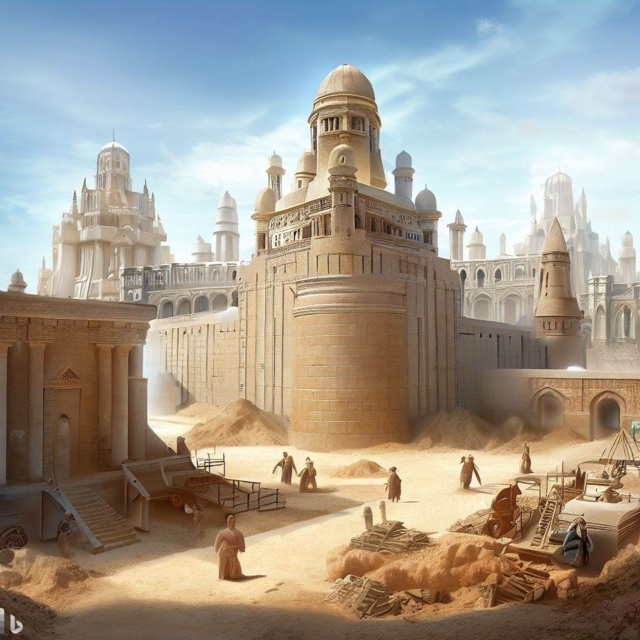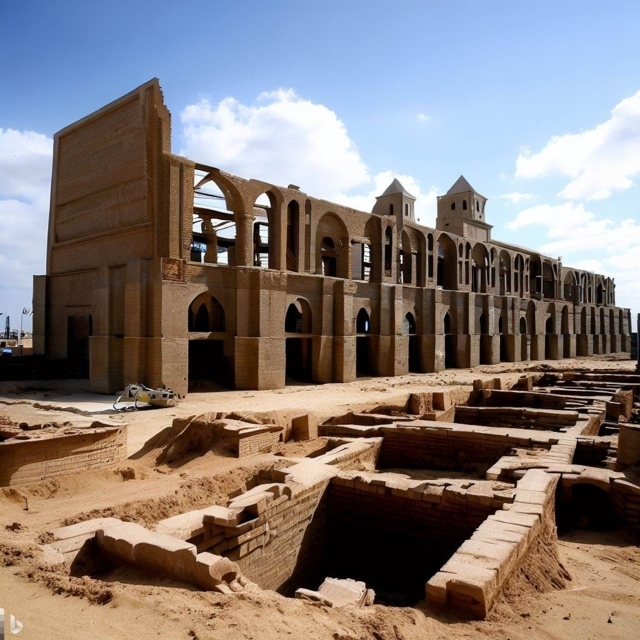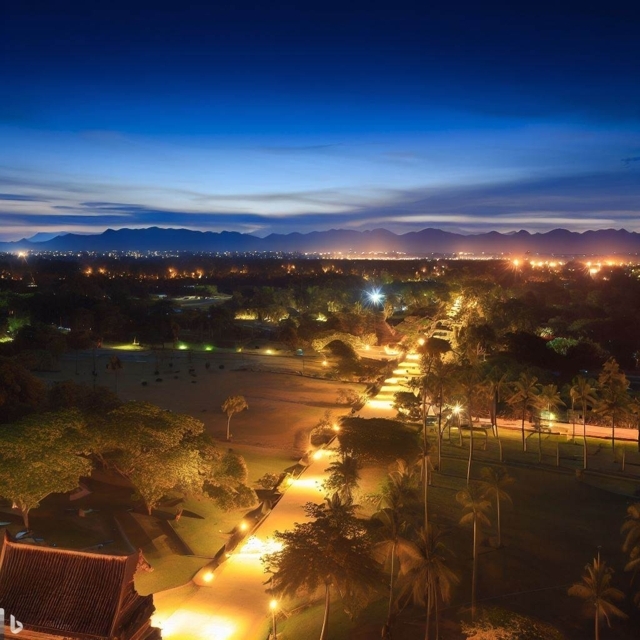Sicily is a land of contrasts, where different cultures and civilizations have left their mark over the centuries. One of the most fascinating examples of this cultural diversity is the Zisa Palace, a splendid summer residence built by the Norman kings of Sicily in the 12th century. The palace is a masterpiece of Islamic art and architecture, reflecting the influence and cooperation of the Arab craftsmen and scholars who lived and worked in Palermo under the Norman rule. In this blog post, I will explore the history, architecture, and legend of this unique monument, which is part of the UNESCO World Heritage Site of Arab-Norman Palermo and the Cathedral Churches of Cefalù and Monreale.
History of Zisa Palace
The name Zisa comes from the Arabic word al-Azīz, meaning “the glorious” or “the splendid”. The palace was conceived as a summer residence for the Norman kings, who wanted to create a luxurious and exotic retreat within a large park called Genoardo (from the Arabic Jannat al-arḍ, meaning “garden” or “paradise of the earth”). The park was inspired by the Islamic gardens of the East, and included fountains, pools, orchards, and pavilions.
The construction of the palace began around 1165, under the reign of William I, also known as William the Bad. He was eager to surpass his father Roger II, who had built magnificent palaces and churches in Palermo, such as the Palatine Chapel and the Martorana Church. However, William I died in 1166, before he could see his project completed. His son and successor, William II, also known as William the Good, continued and finished the work between 1165 and 1180. He was a generous and tolerant ruler, who fostered a peaceful coexistence between Christians, Muslims, and Jews in his kingdom. He also supported culture and science, inviting scholars and artists from various countries to his court.
The Zisa Palace was part of a complex that included other buildings, such as the Cuba Sottana, the Cuba Soprana, and the Uscibene Palace. The complex was connected to the royal palace in Palermo by a long avenue lined with palm trees. The Zisa Palace was used for entertainment and relaxation by the kings and their guests, who enjoyed hunting, feasting, music, poetry, and chess in its halls and gardens.
The palace remained in royal hands until 1194, when Sicily was conquered by Henry VI of Hohenstaufen, the son of Frederick Barbarossa. He married Constance of Hauteville, the daughter of Roger II and the aunt of William II. Constance gave birth to Frederick II in 1194, who became one of the most powerful and enlightened emperors of the Holy Roman Empire. He inherited Sicily from his mother and spent much of his time there. He was fascinated by Arabic culture and spoke Arabic fluently. He also patronized art and science, especially astronomy and natural history. He founded the University of Naples in 1224 and wrote a treatise on falconry called De arte venandi cum avibus (On the Art of Hunting with Birds).
Frederick II used the Zisa Palace as his residence during his visits to Palermo. He also made some modifications to it, such as adding a third floor with a belvedere room overlooking the park. He died in 1250 and was buried in Palermo Cathedral. His son Manfred succeeded him as king of Sicily until 1266, when he was defeated by Charles I of Anjou at the Battle of Benevento. Charles I became the new king of Sicily and moved his capital to Naples. He also confiscated the properties of Frederick II’s supporters, including the Zisa Palace.
The palace fell into decay over time and changed hands several times. In 1635-36, it was bought by Giovanni de Sandoval e Platamone, a nobleman related to the viceroy of Sicily. He transformed the palace into a baroque residence, adding a new floor with balconies, a grand staircase inside, and his coat of arms above the entrance door. In 1808-09, it was sold to Pietro Notarbartolo di Sciara, a prince who restored some parts of it but also added new partitions and floors. In 1955-56, it was acquired by the Region of Sicily, who undertook a major restoration project to bring back its original appearance and function. In 2015, it was inscribed on the UNESCO World Heritage List as part of the Arab-Norman Palermo and the Cathedral Churches of Cefalù and Monreale.
Architecture of Zisa Palace
The Zisa Palace is a remarkable example of Islamic art and architecture in Sicily. It was built by Arab craftsmen and engineers, who used local materials and techniques, such as stone, brick, plaster, wood, and mosaic. The palace has a rectangular plan and is divided into three floors. The main façade faces north-east, to catch the sea breeze that cools the palace in summer. The façade has three large arches, of which the central one is the entrance door. The arches are decorated with geometric and floral patterns, as well as an Arabic inscription in Kufic script that praises God and the king. The inscription was partially damaged by the addition of battlements in the 14th-15th centuries, which gave the palace a more defensive look.
The ground floor of the palace consists of a long vestibule that leads to the central hall, called the Fountain Room. This is the most impressive and important room of the palace, where the king received his guests and entertained them with music and poetry. The room has a high vaulted ceiling supported by four columns with capitals carved with vegetal motifs. The walls are covered with marble panels and niches, some of which have small fountains. The floor is also made of marble and has a large basin in the middle, where water flows from a fountain in the shape of a shell. The fountain is connected to an external pool in front of the palace by a channel that runs under the vestibule. The water creates a pleasant sound and a refreshing effect in the room. The Fountain Room is also decorated with mosaics that depict scenes from nature, such as trees, birds, animals, and fruits. The mosaics are influenced by Byzantine art, but also show some local and Islamic features.
The first floor of the palace is smaller than the ground floor and has two rooms on each side of a corridor. These rooms were probably used as private chambers by the king and his family. They have wooden ceilings with painted beams and windows with wooden lattices that filter the light and create a cozy atmosphere. Some of the rooms also have fireplaces and frescoes that date back to the 14th-15th centuries.
The second floor of the palace was added by Frederick II in the 13th century. It consists of a large central atrium with a domed ceiling and windows on all sides. This room was used as a belvedere, where the king could enjoy the view of the park and the city. The atrium is connected to two smaller rooms on each side, which were also used as private chambers.
Legend of Zisa Palace
The Zisa Palace is not only a historical and artistic monument, but also a place of mystery and legend. According to a popular tradition, the palace is haunted by devils who guard a hidden treasure inside it. The legend says that long ago, two young lovers named Azel Comel and El-Aziz fled from their homeland to escape from her father, who opposed their marriage. They arrived in Palermo and found refuge in the Zisa Palace, where they lived happily for some time. However, one day, her father discovered their hiding place and sent his soldiers to capture them. Azel Comel and El-Aziz decided to hide their treasure in a secret chamber under the palace and then committed suicide to avoid being separated.
Their spirits remained in the palace and became devils who scared away anyone who tried to enter it or find their treasure. They also caused misfortunes to those who lived near it or owned it. For example, they made Giovanni de Sandoval go bankrupt after he bought it in 1635-36. They also made Pietro Notarbartolo di Sciara lose his son after he sold it in 1808-09.
The only way to appease them was to offer them food and wine every year on August 15th, which is also the feast day of the Assumption of Mary. On that day, people would bring baskets full of bread, cheese, fruit, and wine to the palace and leave them at the entrance door for the devils to eat and drink. They would also light candles and pray for their souls.
This tradition lasted until 1955-56, when the Region of Sicily bought the palace and restored it. Since then, the devils have been silent and the treasure has never been found.
Conclusion
The Zisa Palace is one of the most beautiful and fascinating monuments of Sicily. It represents the legacy of Norman-Arab culture, which enriched the island with art, architecture, science, and literature. It also embodies the mystery and legend of Sicilian folklore, which adds charm and intrigue to its history. Visiting the Zisa Palace is a must for anyone who wants to discover the wonders of Sicily and its history. I hope you enjoyed reading this blog post and learned something new about the Zisa Palace. Thank you for your attention and have a nice day.
References
– Kingdom of Sicily – Wikipedia. Retrieved from Wikipedia.
– Kingdom of Sicily | historical kingdom, Europe | Britannica. Retrieved from Britannica.
– List of Sicilian monarchs – Wikipedia. Retrieved from Wikipedia.
– Zisa, Palermo – Wikipedia. Retrieved from Wikipedia.
– Zisa Palace | palace, Palermo, Italy | Britannica. Retrieved from Britannica.
– Abulafia, D. (2011). The Norman Kingdom of Africa and the Norman Expeditions to Majorca and the Muslim Mediterranean. In J. Hudson & S. A. E. (Eds.), The Oxford History of the Laws of England: Volume II 871-1216 (pp. 605–632). Oxford University Press.
– Johns, J. (2002). Arabic Administration in Norman Sicily: The Royal Dīwān. Cambridge University Press.
– Metcalfe, A. (2009). The Muslims of Medieval Italy. Edinburgh University Press.
– Tronzo, W. (1997). The Cultures of His Kingdom: Roger II and the Cappella Palatina in Palermo. Princeton University Press.
Tags
Divi Meetup 2019, San Francisco
Related Articles
Unappreciated Greatness
Life and Legacy of Jahangir of the Mughal Empire. Jahangir ruled over one of the largest empires in human history during his lifetime, yet few people outside of South Asia have heard of him. I aim to shed light on the life and legacy of this remarkable figure,...
The Plague Doctor’s Diary
A Personal Account of the Turin Epidemic of 1656. I am writing this diary to record my experiences and observations as a plague doctor in Turin, the capital of the Duchy of Savoy, during the terrible epidemic that has afflicted this city and its surroundings since the...
The Timeless Beauty of Bustan
Unveiling the Secrets of Saadi Shirazi's Masterpiece.In the realm of Persian literature, few works have captured the essence of love, spirituality, and morality quite like Bustan (The Orchard) by Saadi Shirazi. This 13th-century masterpiece has left a lasting impact...
Stay Up to Date With The Latest News & Updates
Explore
Browse your topics of interest using our keyword list.
Join Our Newsletter
Sign-up to get an overview of our recent articles handpicked by our editors.
Follow Us
Follow our social media accounts to get instant notifications about our newly published articles.









